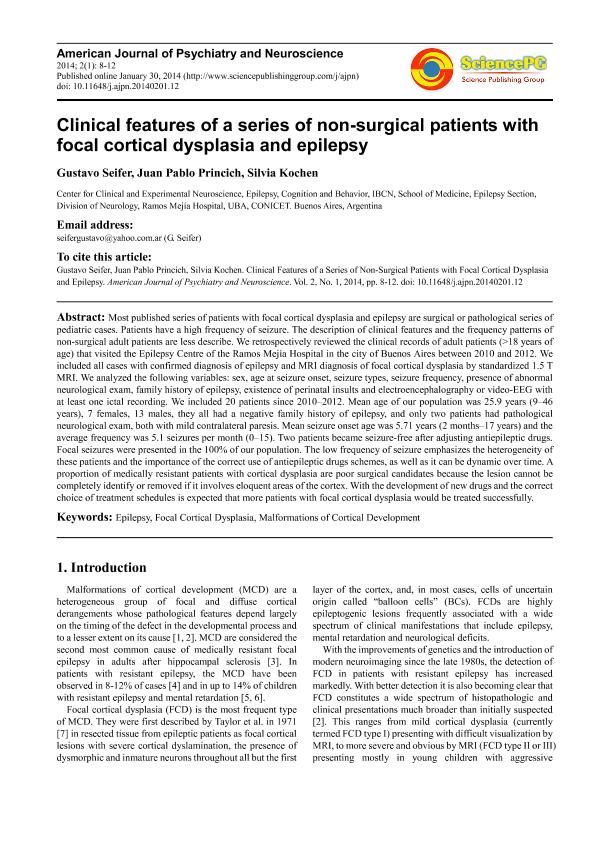Artículo
Clinical features of a series of non-surgical patients with focal cortical dysplasia and epilepsy
Fecha de publicación:
01/2014
Editorial:
Science Publishing Group
Revista:
American Journal of Psychiatry and Neuroscience
ISSN:
2330-4243
Idioma:
Inglés
Tipo de recurso:
Artículo publicado
Clasificación temática:
Resumen
Most published series of patients with focal cortical dysplasia and epilepsy are surgical or pathological series of pediatric cases. Patients have a high frequency of seizure. The description of clinical features and the frequency patterns of non-surgical adult patients are less describe. We retrospectively reviewed the clinical records of adult patients (>18 years of age) that visited the Epilepsy Centre of the Ramos Mejía Hospital in the city of Buenos Aires between 2010 and 2012. We included all cases with confirmed diagnosis of epilepsy and MRI diagnosis of focal cortical dysplasia by standardized 1.5 T MRI. We analyzed the following variables: sex, age at seizure onset, seizure types, seizure frequency, presence of abnormal neurological exam, family history of epilepsy, existence of perinatal insults and electroencephalography or video-EEG with at least one ictal recording. We included 20 patients since 2010–2012. Mean age of our population was 25.9 years (9–46 years), 7 females, 13 males, they all had a negative family history of epilepsy, and only two patients had pathological neurological exam, both with mild contralateral paresis. Mean seizure onset age was 5.71 years (2 months–17 years) and the average frequency was 5.1 seizures per month (0–15). Two patients became seizure-free after adjusting antiepileptic drugs. Focal seizures were presented in the 100% of our population. The low frequency of seizure emphasizes the heterogeneity of these patients and the importance of the correct use of antiepileptic drugs schemes, as well as it can be dynamic over time. A proportion of medically resistant patients with cortical dysplasia are poor surgical candidates because the lesion cannot be completely identify or removed if it involves eloquent areas of the cortex. With the development of new drugs and the correct choice of treatment schedules is expected that more patients with focal cortical dysplasia would be treated successfully.
Archivos asociados
Licencia
Identificadores
Colecciones
Articulos(IBCN)
Articulos de INST.DE BIOLO.CEL.Y NEURCS."PROF.E.DE ROBERTIS"
Articulos de INST.DE BIOLO.CEL.Y NEURCS."PROF.E.DE ROBERTIS"
Citación
Seifer, Gustavo; Princich, Juan Pablo; Kochen, Sara Silvia; Clinical features of a series of non-surgical patients with focal cortical dysplasia and epilepsy; Science Publishing Group; American Journal of Psychiatry and Neuroscience; 2; 1; 1-2014; 8-12
Compartir
Altmétricas




